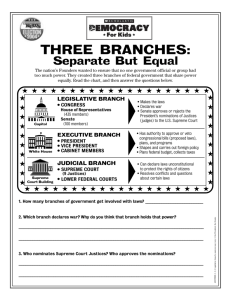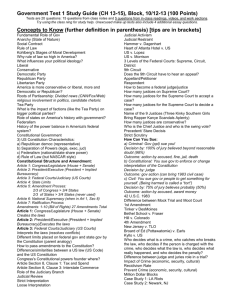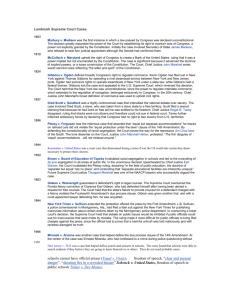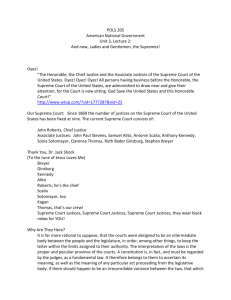Module 6 Lesson 2 Remediation Notes
advertisement
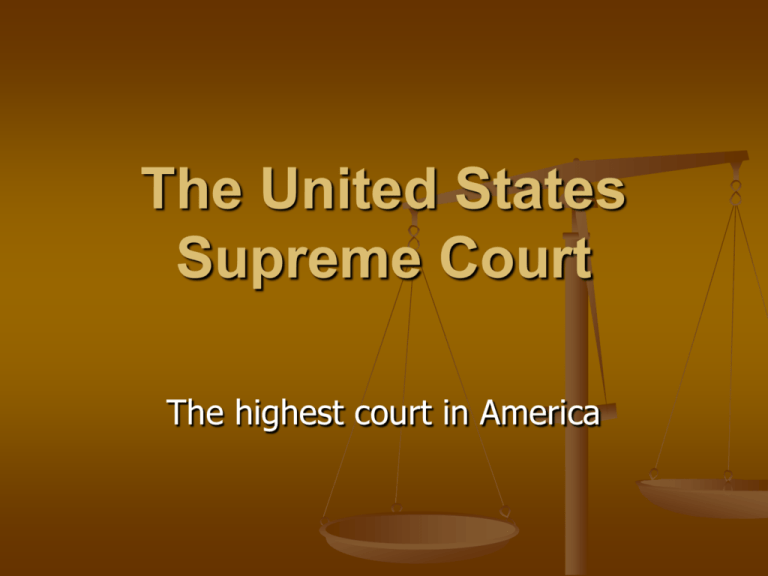
The United States Supreme Court The highest court in America The Supreme Court Justices The main job of the nation’s top court is to decide whether laws are allowable under the Constitution. The Supreme Court has original jurisdiction only in cases involving foreign diplomats or a state. All other cases come to the Court on appeal. In cases the Court refuses to hear, the decision of the lower court stands. The Court has final authority on cases involving the Constitution, acts of Congress, and treaties. Powers of the Court The legislative and executive branches must follow Supreme Court rulings. Because the Court is removed from politics and the influences of special-interest groups, the parties involved in a case are likely to get a fair hearing. The Court’s main job is to decide whether laws and government actions are constitutional, or allowed by the Constitution. It does this through judicial review—the power to say whether any law or government action goes against the Constitution. How Cases Reach the Court The Supreme Court conducts business each year from October until June or July. The Court receives most of its cases on appeal from a lower court, but sometimes a lower court asks for a ruling because it is not sure how to apply the law in a case. Of the more than 7,000 applications each year, the Court agrees to hear fewer than 200. The Court accepts cases that four of the nine justices agree the Court should review. Each month, the justices spend two weeks listening to oral arguments on cases and two weeks writing opinions and studying new cases. They usually select cases that involve important constitutional issues and cases that affect the entire nation. Accepted cases go on the Court docket, or calendar. Order of Supreme Court Cases A law has been challenged and brought to the Supreme Court from a lower court. Lawyers provide justices with briefs about the case. All justices listen to the facts of the case. The justices study the briefs of the case when they recess. Justices vote on the case they have studied during the recess. After voting, the justices write an opinion. The opinion is published in the United States Reports. Types of Opinions After the Court reaches a decision, one justice writes a majority opinion. It presents the views of the majority of justices. One justice is chosen to write the majority opinion. The opinion states the facts, announces the ruling, and explains the Court’s reasoning in reaching the decision. The Court may also write a unanimous opinion when all the justices vote the same way. One or more justices who disagree with the majority may write dissenting opinions. A justice who votes with the majority, but for different reasons, may write a concurring opinion. Reasons for Court Decisions Justices consider how the language of the Constitution applies to the case. They rely heavily on precedents, following the principle of stare decisis—“let the decision stand.” By following precedents, courts make the law predictable and consistent. Social conditions also influence Court decisions. When social conditions change, the Court may make new interpretations of the law. At the same time, the law must be flexible to adapt to changing times. The justices can overrule outdated precedents. For example, in Plessy v. Ferguson, the Court ruled that the Fourteenth Amendment permitted racial segregation. However, by the 1950s, society’s views on segregation were beginning to change. In 1954, in Brown v. Board of Education, the Court ruled that school segregation violated the Fourteenth Amendment, overturning the precedent of “separate but equal.” Justices’ views of the law and the role of the courts also influence their decisions. Like all human beings, justices see the world based on their own life experiences. Their personal views and relationships influence their decisions. Important Supreme Court Cases Miranda v. Arizona Facts of the Case Ernesto Miranda was arrested but not told his right to not confess to the crime (5th amendment - the right to no selfincrimination). He signed a confession and was convicted. Miranda v. Arizona Question Presented Does police interrogation of individuals without notifying them of their right to have an attorney and their protection against selfincrimination violate the Fifth Amendment? Conclusion Yes. The Court ruled that the police must read people their rights, including warnings of their right to remain silent and the right to have an attorney present during interrogations, before being arrested. Texas v. Johnson Facts of the case In 1984, in front of the Dallas City Hall, Gregory Lee Johnson burned an American flag as a means of protest against the Reagan administration policies. Johnson was tried and convicted under a Texas law outlawing flag desecration (destruction). He was sentenced to one year in jail and assessed a $2,000 fine. Texas v. Johnson Question Presented Is the desecration of an American flag, by burning or otherwise, a form of speech that is protected under the First Amendment? Conclusion Yes. The Court held that Johnson's burning of a flag was protected expression under the First Amendment. The government cannot limit a citizen’s right to burn the US flag Gideon v. Wainwright Facts of the Case Gideon was charged in a Florida state court with a felony for breaking and entering. He lacked funds and was unable to hire a lawyer to prepare his defense. The court refused to give him an attorney when he requested one. Gideon defended himself in the trial; he was convicted by a jury and the court sentenced him to five years in a state prison. Gideon v. Wainwright Question Presented Did the state court's failure to appoint counsel for Gideon violate his right to a fair trial and due process of law as protected by the Sixth and Fourteenth Amendments? Conclusion Yes. In a unanimous opinion, the Court ruled that Gideon had a right to be represented by a court-appointed attorney Brown v. Board of Education Facts of the Case Black children were denied admission to public schools attended by white children under laws requiring or permitting segregation according to race. Often, black children had to travel far to get to their school. In Topeka, Kansas, a black student named Linda Brown had to walk through a dangerous railroad to get to her all-black school. Her family believed that segregated schools should be illegal . Brown v. Board of Education Question Presented Does the segregation of children in public schools solely on the basis of race violate the equal protection clause of the 14th Amendment? Conclusion Yes. Segregation of schools is a violation of the Constitution and the segregated schools were not equal as Plessy v. Ferguson required. This court case overturned Plessy v. Ferguson and established that separate was unequal. Plessy v. Ferguson Facts of the Case The state of Louisiana enacted a law that required separate railway cars for blacks and whites. In 1892, Homer Adolph Plessy--who was seven-eighths Caucasian--took a seat in a "whites only" car of a Louisiana train. He refused to move to the car reserved for blacks and was arrested. Plessy v. Ferguson Question Presented Was Louisiana's law mandating racial segregation on its trains unconstitutional and a violation of the equal protection clause of the Fourteenth Amendment? (which says that the government must treat all people equally) Conclusion No. State law did not violate the Constitution The Supreme Court established the concept of separate-but-equal (segregation of public facilities is legal as long as the facilities are equal) Gibbons v. Ogden Facts of the Case In 1808, certain individuals were given a license to operate steamboats on the waterways of the state of New York. This meant that only their steamboats could operate on the waterways of New York. This monopoly was given to them by the state of New York government. This monopoly was very important because steamboats carried both people and goods and was very profitable. One individual, Aaron Ogden, operated steam boats between New York and New Jersey. Gibbons v. Ogden Background Continued Another man named Thomas Gibbons competed with Aaron Ogden on this same route between New York and New Jersey. Gibbons did not have a state of New York license, but instead had a federal (national) license. Gibbons v. Ogden Question Presented Who had the right to issue a license to operate boats on this interstate waterway, the state of New York or Congress (the national government)? Who had the power to regulate interstate commerce? (Interstate commerce is the buying and selling of goods across state borders. This is different from intrastate commerce, which is the buying and selling of goods within state borders. ) Conclusion The Federal government has the power over the states to regulate interstate commerce. Federal ferry licenses prevail over a State ferry Licenses as a result of the Supremacy Clause.

